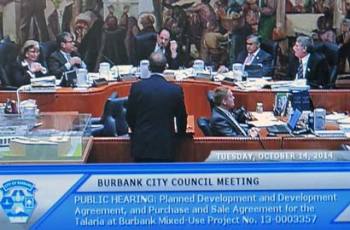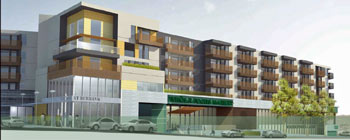
Photo: FLLewis / Media City G — Deputy city planner, David Kriske, answered questions before the Burbank City Council during part two of the public hearing on the Talaria Project October 14, 2014
The city of Burbank is still buzzing about the city council majority’s approval two weeks ago of the controversial Talaria mixed-use project. Tonight the council will revisit the project with the second reading of an ordinance approving Talaria. This is an opportunity for the council to reconsider its decision on the major aspects of this far-reaching development. No one really expects the council to do a 180 and kill the project, which is backed by BMV Investment Co., LLC and Burbank Media Village LLC — the powerful local real estate management Cusumano family. However, the council members still have time to tweak it.
The project was discussed during two city council meetings, October 7 and 14, with input from residents, staff, and the developer. Talaria at Burbank mixed-use project involves 241 luxury apartments and a 42,950 square-foot Whole Foods market at 3401 West Olive Avenue in the Media District. The Whole Foods section includes a sit down restaurant, indoor and outdoor dining, and a full service bar. Also, there will be 760 parking spaces. The 3.86 acre project will require the demolition of 16 existing buildings –among them, affordable apartment units, offices, retail space, Dimples karaoke bar and Victory Baptist Church.
Talaria was granted the distinction of being “exceptional,” which allowed the project to exceed the maximum density of 58 units an acre by 8 percent or 63 units per acre. The project received the exceptional classification for including enhancements such as installing electric vehicle charging stations, having a portion of the project’s energy needs from on-site renewable sources, and encouraging bicyclist and pedestrian traffic. The staff report recommended Talaria be considered exceptional “…based on the elements proposed that will benefit the community, not just those living at or visiting the project.”
Vice-mayor/council member, Bob Frutos, had some concerns about traffic, but overall was impressed with the project.
Jess Talamantes, Emily Gabel-Luddy, and Gary Bric agreed with Frutos and voted “yes” on four resolutions covering the development agreement, environmental impact report, alcohol sales at the Whole Foods, and the sale and vacation of city-owned parcels in the area. They pretty much rubber stamped the project with two modifications: raise the developer’s contribution to street improvement in the neighborhood from $150,000 to $250,000 and set aside $750,000 for neighborhood protection.
The city staff repeatedly down played the traffic impact of the project. Many residents in the nearby neighborhoods didn’t buy it. During the public hearing at the October 7 city council meeting, dramatic videos were shown of traffic problems residents say will only get worse with Talaria.
The mayor, Dr. David Gordon, was the lone “no” vote on each of the resolutions. Dr. Gordon tried to convince his fellow council members to take a closer look at Talaria, especially the decision to allow the developer to purchase city-owned parcels in the project area for $1.2 million — which was on the low end of property appraisals.
Caught in the middle of all of this, 90 or so residents in the affordable units that will be torn down to make way for Talaria. Those units, as well as all other buildings on the project site, are owned by the Cusumanos.
Later, Michael Cusumano told the council his company would make efforts to find homes for the displaced residents in some of its rental units. However, there are reports the Cusumanos have been sending mixed messages, particularly in the case of the Victory Baptist Church and its congregation of several hundred.
These tenants should not have to depend or hope for the good will of the developer/property owner. The city council should be looking out for these Burbank residents. The council can do this by upping the price of the city-owned parcels by a million or so. That extra money could be used to assist the tenants and the church with relocation and new housing. Also, whatever is left over could be used to ease the traffic headaches in the nearby neighborhoods.
The size of Talaria is a problem. As Dr. Gordon suggested, it should be reduced, maybe by a third or even a quarter. That kind of reduction would cut back on the traffic generated by the project. It’s not too late in the game to make changes. After a vote was taken in December of 2010 on the controversial North Screenland Drive sidewalks, councilman, Gary Bric, changed his mind and the issue was brought back to council for further discussion.
All it would take for the council majority to make changes in the Talaria project is courage and true dedication to the best interest of the residents of this city.



